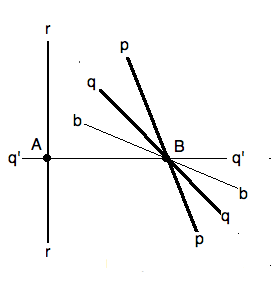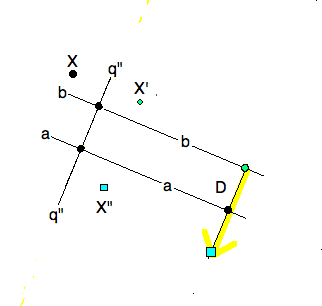Let $ \gamma = \sigma_r\sigma_q\sigma_p $, with the three mirrors neither concurrent nor mutually parallel. Note that we are not requiring all three intersections $ (rq), (qp), (pr) $ to be finite. Two of the three mirrors could be parallel, as long as the third mirror crosses one of them. (Exercise: if two intersections were ideal, then one mirror would be the ideal line, which we excluded before.) We shall proceed with the assumption that $ B = (qp) $ is a finite crossing. We leave the other two cases for an exercise.
|
Given three mirrors $ p,q,r $, with the first two intersecting at $ (pq)= B $. |
Rotate $ p,q $ to $ b,q' $ so that ` q' _|_ r`. |
2.1. Step 1
If $ q _|_ r $ then relabel $ q = q', b = p $ and go to the next step. Otherwise, drop the perpendicular $ q' $ from $ B $ to mirror $ r $. Now recalibrate the rotation $ \rho_B := \sigma_q \sigma_p $ using $ q' $ as the preferred mirror through $ B $ and using a "before" mirror $ b $ so that $ \rho_B = \sigma_{q'} \sigma_b $.
|
Rotate $ q',r $ about $ (q'r)=A $ to $ q'', a $ until $ q''_|_b $ |
2.2. Step 2
We now have $ \gamma = \sigma_r \sigma_{q'} \sigma_b $ where ` r _|_ q' `.
If $ q' _|_ b $ the relabel $ q' = q", r = a $ and go to the next step. Otherwise, drop the perpendicular $ q" $ from $ A = (rq') $ to $ b $. Now recalibrate the rotations $ \rho_A := \sigma_r \sigma_q' $ using $ q" $ as the preferred mirror through $ A $ and using an "after" mirror $ a $ so that $ \rho_A = \sigma_{a} \sigma_q" $.
Note that the recalibration preserves the angles: ` r_|_q'` hence ` a _|_ q" `. In fact, the rotation $ \rho_A $ is through $ 180^o $, and so it is the central reflection $ \sigma_A $ as well.
|
A isometry with three mirrors $ \triangle pqr $ recalibrated to be the |
composition of three pairwise perpendicular mirrors $ a, q''m $ and $ m, b $ |
refactored as $ X' = \sigma_m $ and $ X''= \tau_D $ . |
2.3. Step 3
Either by chance, one or two recalibrations we have recalibrated $ \gamma = \sigma_a \sigma_m \sigma_b $, where we have relabelled $ q" = m $. Moreover, looking back, we now also have the $ a || b $ and both are perpendicular to $ m $ .
|
Following the transformation of a point $ X $ by a glide-reflection, |
(black dot to small square) reveals the symmetries of the most charming isometries. |
2.4. Conclusion
We can therefore write the glider $ \gamma = \sigma_A \sigma_b = \sigma_a \sigma_A $ as a reflection followed or preceded by a central reflection.
Moreover, a pair of reflections in perpendicular mirrors commute. (Exercise: use the conjugacy theorem). So swapping $ a,m $
$ \gamma = \sigma_m \sigma_a \sigma_b = \sigma_m \tau_D $
or swapping $ m,b $
$ \gamma = \sigma_a \sigma_b \sigma_m = \tau_D \sigma_m .$
It is from this the glider got its name, like a dance-step instruction: Take a step (translation) and change feet (reflection).



